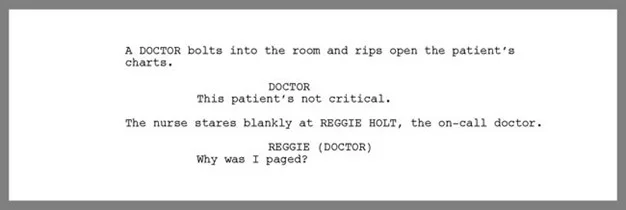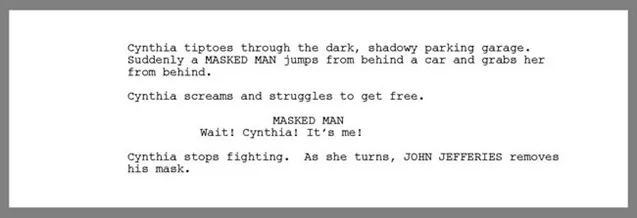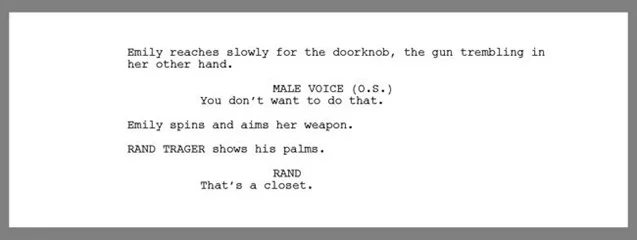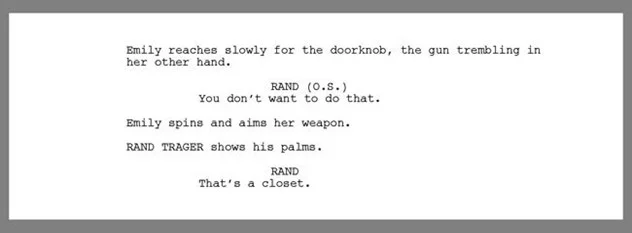
Screenwriting ABCs Script Formatting
Capitalization: Character Intros
by T. J. Alex
Book Excerpt, 5 pages
Viewed by: 38 Residents and 176 Guests

Capitalization: Character Intros
When trying to decide when to capitalize a character name in Direction, keep this in mind:
• Capitalize any Character with a Speaking Role the first time they are introduced.
• If a character has a non-speaking role, but is still somehow important to the film, Capitalize the name. Some characters may be mimes or mutes or somehow important to the film's emotional impact.
• Once a character has been introduced, that character's name may be lowercase from then on (with proper names having the first letter Capitalized, of course). Here is a basic Direction paragraph that introduces a new character:

Now let's look at other rules, examples, and specialized situations.
Minor Characters:
Minor Characters with no speaking roles may be left in lowercase:

In the example above, the hostess and the waiter are minor characters and do not speak anywhere in the film, and therefore need not be Capitalized.
Also, as a general rule, never Capitalize groups of people, only individual characters:

If a minor character with a speaking role has a generic name (most will, as they aren't important enough to warrant proper names), make sure to not only put the name in ALL CAPS the first time he/she is introduced, but remember to Capitalize the first letter of that generic name from then on. Here is an example:

Possessive:
If a name needs to be in ALL CAPS, but it is followed by a possessive, DO NOT Capitalize the possessive "s":

Generic Name Before Proper Name:
Sometimes a character will be introduced with a generic name before having their proper name revealed. In these situations, make sure to Capitalize both instances of the name. Here is how that might look:

Although there is nothing wrong with the example above, sometimes the reader can get confused if he/she doesn't realize the DOCTOR and REGGIE are the same person. Clarity is always key, so if you read what you've written and fear the reader might get confused, here is a way to write it to clue the reader that REGGIE and the DOCTOR are one in the same:

After the initial REGGIE (DOCTOR) clarification in the Character Heading, the writer can simple write REGGIE as the Character Heading from then on.
Of course, in my opinion, the best option would be to avoid any confusion all together by calling the character DR. REGGIE HOLT the moment he comes in the room.
There may be a situation where a generic name is quickly followed by a proper name, with no Dialogue in between. In such cases, you don't need to Capitalize the generic name. Here is one such situation:

Secret Identities:
For dramatic effect a character's proper name might not be revealed immediately. Here is an example of how that might look:

In the example above, I doubt the writer would need to put JOHN (MASKED MAN) as the Character Heading the next time John speaks. The fact he was the person behind the mask should be obvious.
Of course, some experts say that there is no need to Capitalize JOHN JEFFERIES in situations such as this. Either way is fine, but I advise erring on the side of caution and Capitalizing.
Off-screen Voice:
Let's say that a character who has not been introduced speaks OFF SCREEN. Here is one way to handle such a situation:

But just because you haven't introduced the character in Direction doesn't mean you can't call the character by name in a Character Heading. Here is another way to format the same scene:

FYI: (O.S.) stands for "off screen".
Character Age Changes:
If a character is shown at two different points in his/her life, such as a character who is 30something throughout a film, but flashes back to her childhood, often two different actors will be required to play the same character. In cases like this, you must Capitalize the character name twice; once the very first time the character is introduced, and once again when writing the flashback scene the first time the character is introduced at a different age. Here is an example:

In the example above, it is obvious, barring use of fancy-schmancy, computer-aided editing, two different actors will be needed to play ALBERT STUART in this film.
Sometimes whether or not producers or directors will use two actors isn't always so clear. Sure, an actor COULD play a 25-year-old throughout a film, but a 90-year-old man at the end of a film with some applied makeup (and they often do), but a director might have a different actor in mind for the older role. If in doubt, Capitalize both.
Character Mentioned Before Introduction:
Every once in a while, we'll see a character's name appear somewhere in the script even though the audience has not met the character officially. Check out these examples:
In Dialogue:
If a character mentions another character in Dialogue who has not been introduced yet, DO NOT Capitalize the name:

In Scene Headings:
Sometimes a Scene Heading will allude to a character who the audience has yet to meet. In cases such as these, DO NOT consider the Capitalized name in the Scene Heading the introduction of the character. Still put the name in ALL CAPS the first time it is mentioned in Direction, like this:

In Direction:
There may be a scenario in which a character has yet to be introduced in the Direction paragraph, yet the name of the character is. Here is one such situation:

In the first Direction paragraph above, President Bill Gray is mentioned, but he still isn't on screen. Therefore his name is in lowercase.
In the next paragraph, PRESIDENT GRAY emerges from the Air Force One and makes his first official appearance in the film, therefore earning the ALL CAPS treatment. Let's just hope he doesn't stumble down those steps.
----------------------------------------
For more screenplay formatting rules and advice, check out the book, Your CUT TO: Is Showing! by T. J. Alex or visit www.scripttoolbox.com. From there, please like the page on Facebook, and share it with your friends.
If you have any formatting questions, please email T. J. at tj@tjalex.com.




